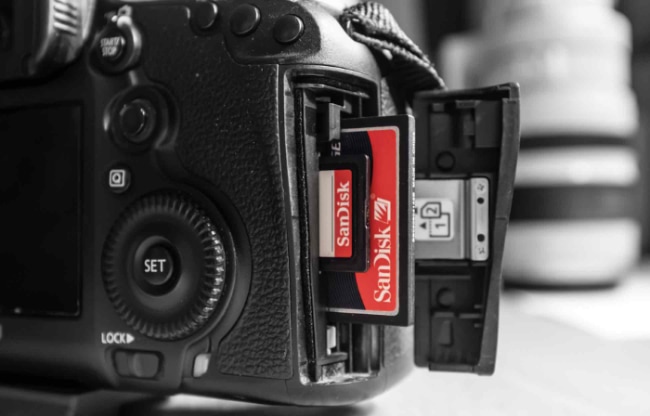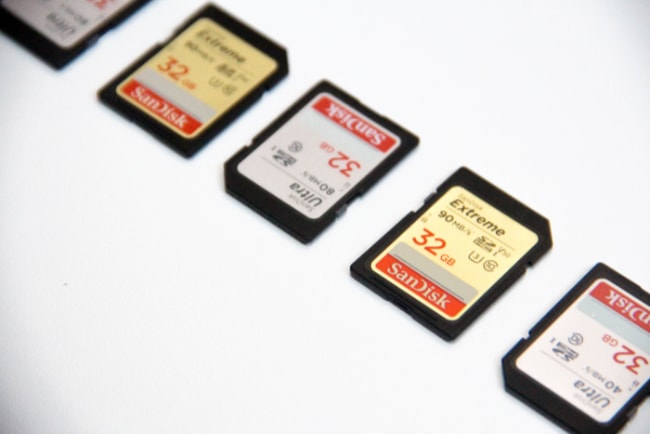SanDisk Extreme vs. Ultra: Tech Specs Compared

Selecting the right memory card is crucial for capturing life's moments seamlessly, whether it's a breathtaking landscape or a candid family photo. Amidst a plethora of choices, SanDisk stands out as a frontrunner, offering a range of memory cards tailored to diverse photographic needs.
Two of its most popular lines, SanDisk Extreme and SanDisk Ultra, cater to different levels of photography enthusiasts and professionals.
Primary Differences in Usage
Memory cards serve as the unseen yet essential enablers for photographers and videographers, directly influencing the performance and quality of their work. The SanDisk Extreme and Ultra lines, although from the same reputable family, are designed with distinct functionalities in mind.
These differences are critical in determining which card is the most suitable for a user's specific equipment and shooting demands.
Video Recording Capabilities
The SanDisk Ultra is adept for recording 1080p HD video, making it a reliable choice for standard video capture requirements. It is tailored towards the casual user who might be capturing family events, simple vlogs, or amateur content.
On the other hand, SanDisk Extreme steps up the game by supporting 4K/UHD video recording at consistent speeds, catering to professionals and enthusiasts who demand higher video fidelity and detail for their projects.
High Megapixel Photography
When it comes to photography, the distinction becomes even more pronounced. Owners of high megapixel cameras, or those who engage in rapid, continuous burst shooting, will find the faster write speeds of the SanDisk Extreme a significant advantage.
This speed is necessary to efficiently handle the large volume of data produced by such intense photography sessions. The Ultra line, while competent, may not keep pace with the demands of advanced photography techniques.
Target User Base
SanDisk has strategically positioned the Ultra line for amateur and beginner photographers, focusing on affordability and broad compatibility with entry-level cameras and smartphones. The Extreme range, conversely, aims at a more demanding segment of the market, appealing to professionals and serious hobbyists who require swift write speeds for raw shooting and high-resolution video capture.
Read/Write Speeds
The performance of memory cards is often judged by their read and write speeds, metrics that determine how quickly data can be saved to and read from the card. These speeds are not just numbers on a spec sheet; they translate into real-world performance differences, impacting everything from the speed of transferring photos to a computer to the ability to record high-resolution video without interruptions.
Maximum Write Speeds
SanDisk Ultra and Extreme series show a clear differentiation in their write speeds. The SanDisk Ultra reaches a maximum write speed of 80MB/s, which is suitable for standard photography and 1080p video recording.
In contrast, the SanDisk Extreme offers a higher write speed of up to 90MB/s. This increased speed contributes to shorter buffering times, making it a more efficient choice for 4K video recording and high-speed photography.
Furthermore, the Extreme series benefits from Ultra DMA technology, doubling the read and write speeds compared to the SanDisk Ultra Plus.
Read Speeds and Buffering
Read speed, which determines how quickly data can be accessed from the card, is another critical factor. The SanDisk Ultra offers a read speed of up to 120MB/s, while the Extreme variant goes further, offering a read speed of up to 160MB/s for certain models.
This increased read speed is particularly beneficial when transferring large files or high-resolution images to a computer, thereby enhancing the overall workflow efficiency.
Speed Class and UHS Rating
Both card ranges come with a Speed Class of C10, indicating a minimum write speed of 10MB/s, which is sufficient for Full HD video recording. However, in terms of the UHS (Ultra High Speed) class, SanDisk Extreme cards are rated as U3, meaning they have a minimum write speed of 30MB/s.
This is higher than the U1 rating of SanDisk Ultra, which stands at a minimum of 10MB/s. These ratings are crucial for users who need consistent performance for high-resolution video recording and rapid burst photography.
Storage Capacities and Formats
The capacity and format of a memory card are crucial in determining its suitability for various devices and applications. These factors dictate not only how much data the card can hold but also its compatibility with different types of cameras and devices.
SanDisk's Ultra and Extreme lines offer a range of capacities and formats, catering to a diverse spectrum of storage needs and device requirements.
Range of Storage Capacities
SanDisk Ultra memory cards come in an extensive range of capacities, from as low as 16GB to as high as 1TB. This broad spectrum makes them a versatile choice for users with varying storage needs, from casual photography to extensive video recording.
On the other hand, SanDisk Extreme cards are available in capacities up to 256GB, which, while lower than the maximum offered by Ultra, is typically sufficient for most high-performance use cases, such as 4K video recording and high-speed burst photography.
Memory Card Formats
Both SanDisk Ultra and Extreme memory cards are available in various formats, including SD (Secure Digital), SDHC (Secure Digital High Capacity), and SDXC (Secure Digital Extended Capacity). The format is an important consideration as it affects the card's compatibility with different devices.
SD cards are universally compatible with all devices supporting SD, SDHC, and SDXC. SDHC cards, formatted in FAT32, work with most modern devices but may not be compatible with older devices that only support SD.
SDXC cards, using the exFAT format, are ideal for newer devices, offering higher capacities and better performance but require SDXC-compatible equipment.
File System and Compatibility
The file system used in these cards also plays a crucial role in their functionality. SD cards use the FAT16 file system, while SDHC cards use FAT32, and SDXC cards employ exFAT.
These file systems have different file size limits and performance characteristics. For instance, FAT32 restricts individual file sizes to 4GB, which can be a limitation for extended high-resolution video recordings.
The exFAT system of SDXC cards, used in higher capacity SanDisk Extreme models, allows for larger file sizes and is generally faster, making it more suitable for demanding photography and videography tasks.
Durability and Warranty

Durability and warranty are critical factors when it comes to choosing memory cards, especially for photographers and videographers who often work in challenging environments. Both the SanDisk Extreme and Ultra lines boast robust durability features, ensuring that your data remains safe even in demanding conditions.
Additionally, the warranty offered by SanDisk provides an extra layer of assurance, adding value to your investment in their products.
Durability Standards
SanDisk takes pride in the durability of its memory cards, with both the Extreme and Ultra series undergoing rigorous testing to ensure they can withstand extreme conditions. These cards are designed to be waterproof, capable of withstanding up to 72 hours in salt or freshwater.
They are also temperature resistant, functioning flawlessly in temperatures ranging from -13 to 185°F (-25 to 85°C). Moreover, they can endure up to 500Gs of shock and survive drops of up to 5 meters.
Their durability is further enhanced with immunity to airport X-rays and magnetic field damage. This level of robustness makes them reliable choices for use in a wide range of environments, from outdoor adventures to professional photo shoots.
Warranty Coverage
When it comes to warranty, SanDisk provides different levels of coverage for the Ultra and Extreme series. The Ultra line offers a 10-year limited warranty, giving users a significant period of coverage for their investment.
In contrast, the SanDisk Extreme series steps up the offering with a lifetime limited warranty. This extended warranty period reflects the confidence SanDisk has in the durability and longevity of the Extreme series.
It's important to note that while a longer warranty period is advantageous, the rapid evolution of technology and changing storage needs might lead users to upgrade their memory cards within a decade, making the practical difference in warranty length less significant for some users.
Price Comparison
The cost of a memory card is a significant consideration for many buyers, balancing the need for quality with budget constraints. SanDisk, a reputable brand in the storage solutions market, offers its Ultra and Extreme lines at different price points.
This pricing strategy reflects the varied features and capabilities of each line, catering to both budget-conscious consumers and those requiring high-performance storage solutions.
SanDisk Ultra Pricing
The SanDisk Ultra series is known for its affordability, making it an attractive option for amateur photographers and general users. Its price reflects its position as a card suited for less demanding applications like standard photography and 1080p video recording.
The range of capacities available in the Ultra series also means a broad spectrum of pricing options. Users can choose from lower capacity cards at a minimal cost to higher capacity ones that still maintain a reasonable price tag.
For instance, the SanDisk Ultra microSD 512GB model is priced around $89.99, offering a substantial storage capacity at a cost-effective price.
SanDisk Extreme Pricing
In contrast, the SanDisk Extreme series, catering to more demanding applications like 4K video recording and rapid burst photography, is priced higher than the Ultra series. This increase in price is justified by the advanced features such as higher write speeds, greater durability, and the inclusion of technologies like Ultra DMA for faster data transfer.
Despite being more expensive, the Extreme series represents a valuable investment for professional photographers and videographers who require reliable and high-speed storage. For example, the SanDisk Extreme Plus 1TB microSDXC card is priced at approximately $169.99, reflecting its high capacity and enhanced performance features.
Evaluating Cost vs. Performance
When considering the price difference between the SanDisk Ultra and Extreme series, it is essential to evaluate the cost relative to the performance and capacity needs. While the Ultra offers affordability and is sufficient for basic storage needs, the Extreme provides advanced features that justify its higher price for users with more intensive storage requirements.
This distinction in pricing allows consumers to choose a memory card that not only fits their budget but also aligns with their specific usage needs and device requirements.
Conclusion
Selecting between SanDisk Ultra and Extreme memory cards requires careful consideration of one’s specific needs and the intended use of the card. For users involved in standard photography and 1080p video recording, the SanDisk Ultra series stands out as an affordable, reliable choice with a wide range of storage capacities.
It offers a balance between performance and price, making it ideal for amateurs and general usage.
Conversely, the SanDisk Extreme series caters to a more demanding audience, such as professional photographers and videographers requiring high-speed data transfer for 4K video recording and rapid burst photography. While it comes at a higher price point, the investment is justified by its enhanced features, including greater durability, faster write speeds, and advanced technologies like Ultra DMA.
Both lines boast impressive durability and varying warranty periods, underscoring SanDisk's commitment to quality. The choice ultimately hinges on individual requirements for storage capacity, speed, and budget.


